Here Are The Key Dates As The World Reopens From The Coronavirus Coma
by Tyler Durden
ZeroHedge.com
Fri, 04/24/2020
On April 16, the Trump administration released guidelines for reopening of the US. The Administration has suggested that Governors base their plans on criteria consisting of three aspects:
1.a downward trend in documented cases over 14 days, or a downward trend in testing positivity rates over 14 days while
2.maintaining the testing volume;
3.a downward trend in symptoms-based reporting systems, including ILI and COVID-like syndromes, for 14 days;and
4.enough capacity in hospitals and testing
Of course, as we previously documented, some states – and countries – are eager to restore some semblance of normalcy starting with Georgia, which hopes to reopen its economy starting today. Below, courtesy of BofA is a tentative calendar of the most notable publicly announced reopening events in the coming month.
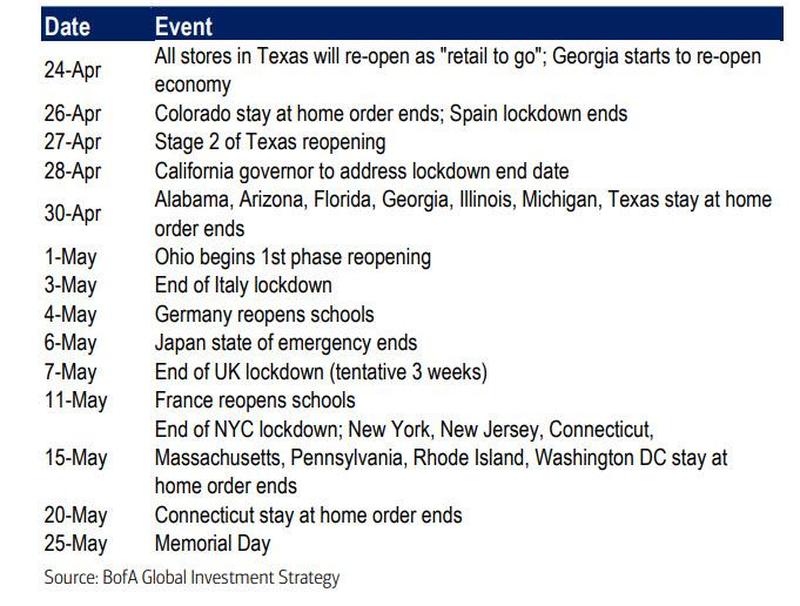
The above table is a more detailed version of a timeline that was previously presented (and recently updated) from Deutsche Bank:
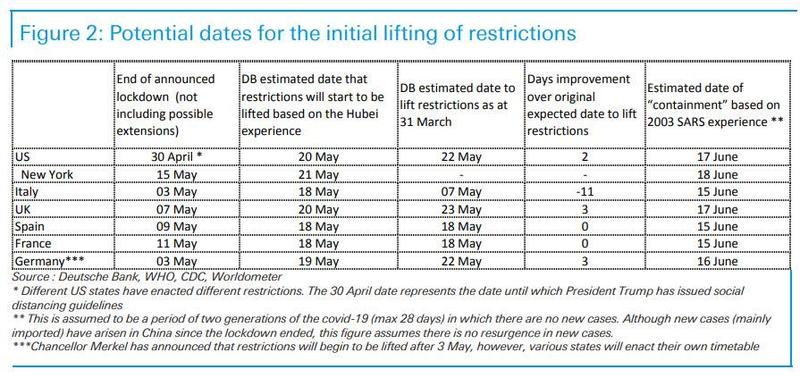
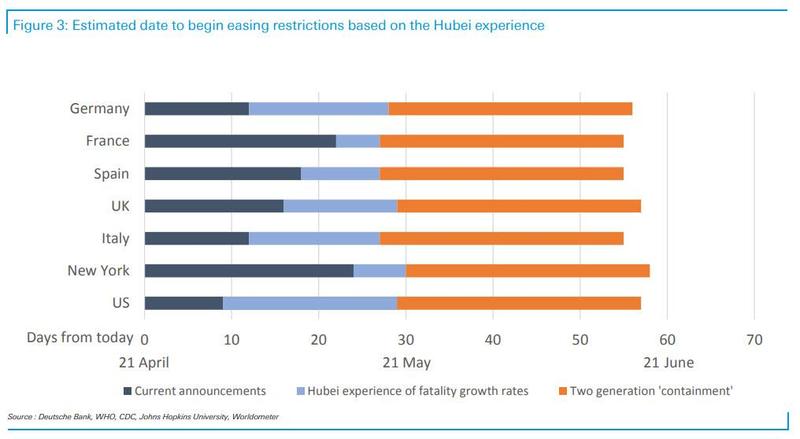
The process of reopening
As Deutsche Bank’s Jim Reid previously detailed in his report “The Exit Strategy”, there is a specific step-by-step process of how reopening may work. Since then, announcements by several countries indicate they are planning for this style of gradual reopening. Spain has begun to allow construction and manufacturing staff back to work, and several countries have outlined plans to reopen schools and small stores as part of the first step. It is likely that only once countries have reopened themselves domestically will they reopen their borders.
As countries begin to reopen, a key consideration is how to deal with the second wave of the virus that is likely from increased activity. This is being weighed up against the increasing awareness of the health problems associated with isolation and lockdown itself.
Given various countries announcing different measures, a certain level of coordination is optimal. Hence why the EU is expected to present a continent-wide blueprint for lifting restrictions next week and is urging countries to coordinate their exit plans. Closely watched will be any recommendations for lifting the border restrictions on travellers from outside the Schengen area. The WHO this week released its six-step guide to assessing the criteria for reopening.
In order to more fully reopen, many countries have pointed out that ‘test and trace’ capacity must be improved and widely implemented. Whilst testing capacity will be ramped up shortly, the ‘trace’ component could see the biggest change as people adopt new technology.
Indeed, technology is already playing a role in the management of the virus in various countries. Apple and Google are adding features to their smartphones that will provide alerts if users have come into contact with a person that has tested positive for Covid-19. The program will be opt-in, but could help monitor up to one-third of the world’s population. The rollout is planned for mid-May.
This technology, and others like it, comes as the “Pan-European Privacy-Preserving Proximity Tracing” initiative – a coalition of technologists and scientists – work on a standard that will allow for effective smartphone-based tracking while preserving individual privacy. This trend also ties into calls from some US politicians to set up a national registry to track people immune to the coronavirus, similar to databases for vaccinations.
* * *
Shifting back from the world to the US, Morgan Stanley writes that while most states will begin to meet some virus containment criteria in late-April to mid-May, Morgan Stanley believe a significant increase in testing volume and contact tracing remains an important milestone to reopen safely. Further, many states including AZ, CO, CT, IA, ID, IL,LA, MA, MD, NE, NJ, NV, NY, PA and VA all have test positivity ratios that are still too high.Further, NY,LA and SD all have declining testing volume in the last week which complicates their data trends.
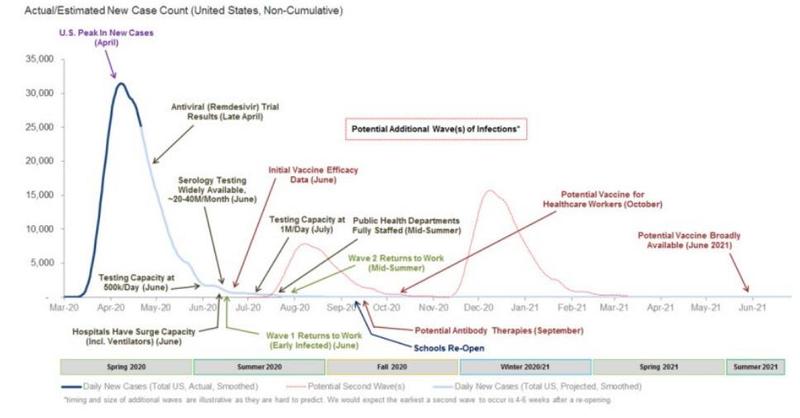
The next chart shows tentative phased reopening dates based on the Trump Administration criteria as well as Morgan Stanley’s own containment criteria. Specifically, the chart lists projected milestones to trigger the three reopening phases for each state based on the Trump Administration criteria. While meeting the criteria alone is probably not a sufficient condition to reopen, Morgan Stanley’s Matthew Harrison provides them as one piece so investors can gauge potential timelines. In the last column, the bank provide an additional containment measure, when the reproduction rate (R0) equals 1 (infected individuals are no longer infecting others) which is arguably the most important threshold for re-opening.
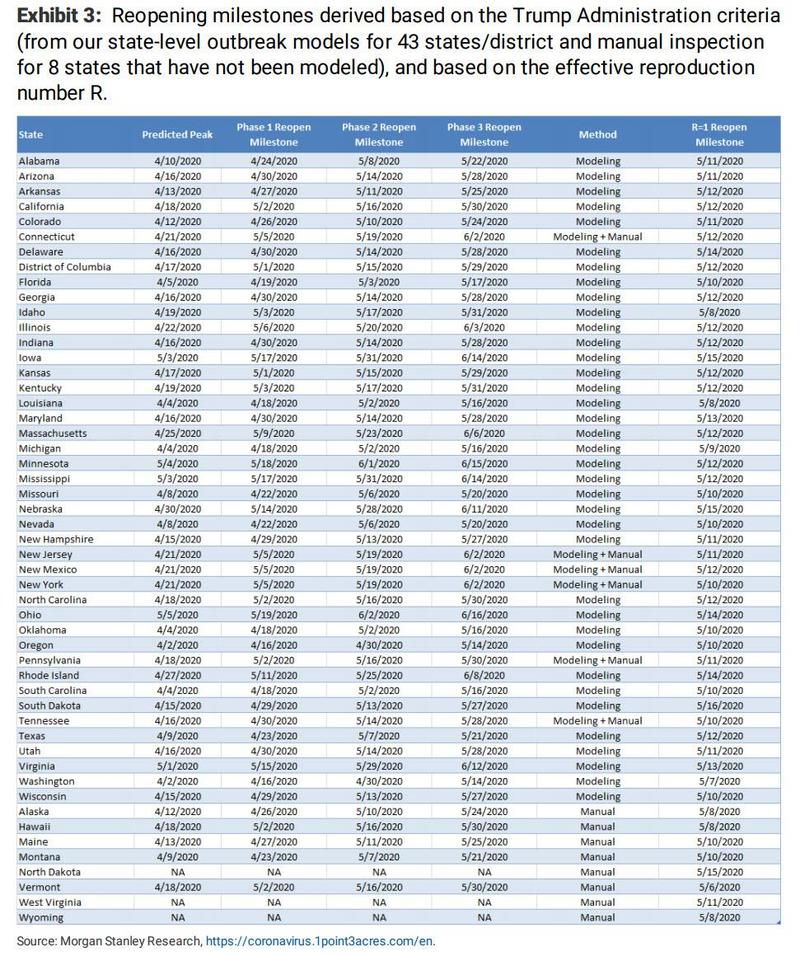
A few more points here: While many states can meet the14 day decline in new case criteria, their testing positivity rates remain high confounding this as a sole variable for reopening: in an ideal scenario, states should realistically have 14 days of downward trajectory, an effective reproduction number (R) close to 1 which suggests new patients are not infecting others and testing positivity rates in the single digit percentage. Based on these criteria, MS provides its own estimates for when we expect States to meet virus containment measures. On average these timelines are ~10-20 days later than the date solely based on the 14 day criteria.
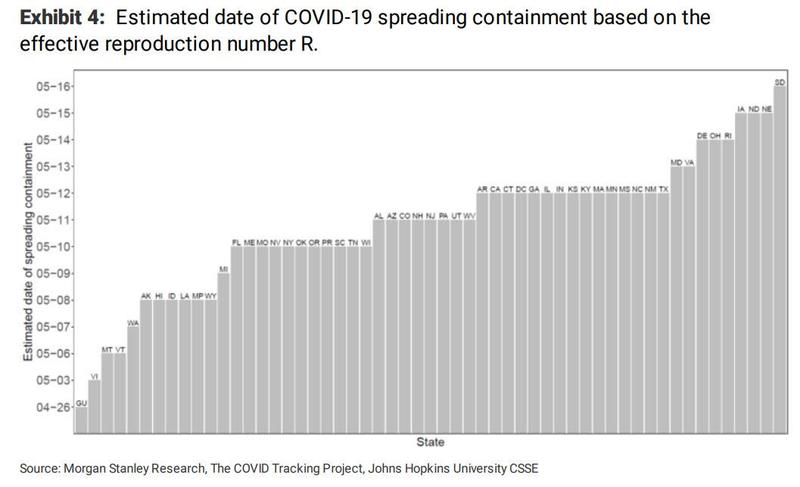
Finally, below is Deutsche Bank’s summary “exit strategy” status update and announcements for six key countries planning to reopen in coming days.
United States: Much is decided at the state level, though there are federal guidelines that have been extended through to 30 April. Last week, President Trump issued guidelines for reopening civic and economic life. This involves a three-phase process. To commence, the relevant state or region should show a downwards trajectory of flu-like illnesses and confirmed covid-19 cases for two weeks, and hospitals should be treating patients without crisis care and have testing programs in place for healthcare workers.
Phase one reopenings include large venues, restaurants, and gyms if physical distancing protocols remain in place n Phase two reopenings include schools and bars with certain capacity restrictions. Non-essential travel can resume.
Phase three reopenings include visitation to senior care facilities and hospitals, and the reduction of physical distancing protocols in public areas including cinemas, sporting venues, and bars. Workplaces can resume without restrictions.
Texas and Vermont will begin easing some restrictions this week
New York Governor Andrew Cuomo has announced plans to reopen New York State’s economy over the coming 18 months. Businesses will be assessed based on the essential nature of their products and services, as well as the potential health risks involved in the particular business reopening. The governor has admitted that while widespread testing is essential, it cannot yet be implemented.
Governors in California and Oregon have outlined a framework that they will use to reopen the west/northwest region of the US. Some of the benchmarks include seeing ICU/hospital capacity open up, the ability and rollout of mass testing, and the ability to track new cases effectively.
Reports indicate the CDC and FEMA have begun drafting plans to end distancing measures and reopen economies. The plan describes a program that splits the country into regions based on risk profiles, with low-, moderate- and high-risk sections. Low-risk areas could open earlier, though not before 1 May, while moderateand high-risk areas would come later. Widespread testing remains the barrier to implementation
The Rest…HERE

